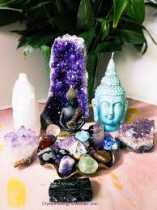
If you want to make a pendant shaped like the crescent Moon, you've basically got three options: two horns up, one horn up, or two horns down. If you wanted to over-interpret, you could read these as Moon rising, zenith Moon, and Moon setting, respectively.
In that case, this one is Moon Come Down for sure.
The silversmith who, during the Baltic Bronze Age, made the original on which this little silver amulet is based chose the third option. What makes this lunula (“little Moon”) unique is its Double Moon shape. From one crescent grows another. One Moon holds another in its arms.
If you want, paradoxically, a static symbol of change, you'd go far to find one better than the Moon. This double Crescent redoubles that symbolism. It's a pregnant Moon, one Moon giving birth to another, to itself: Moon within Moon, as seed within seed, forever.
The dotted circles that dapple, crater-like, its surface intrigue me: their irregular distribution lends a certain visual dynamism, even a kinetic quality, to the piece. Do we see here merely the proverbial horror vacui of the Bronze Age craftsman? Or is there meaning to be derived?
Are they, perhaps, Suns? Shining with mirrored light, the Moon contains the Sun.
(Circles within circles, crescents within crescents.)
Or are they Full Moons, which every Crescent contains within herself?
I count twenty. If they're intended as Full Moons, along with the two Crescents, that makes twenty-two: a number of no obvious lunar (or, for that matter, solar) association. Either there's some symbolism here too recondite for my learning, or—this would be my guess—they're simply the number required to fill the space.
As I said, over-interpretation.
Witches, of course, have always been a people of the Moon. I kiss the little silver pendant and hang it around my neck.




















